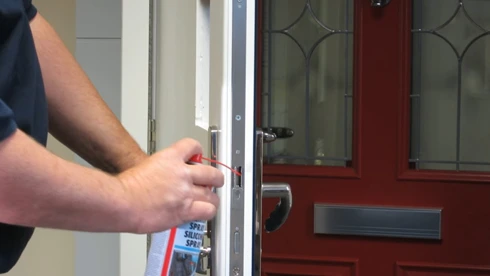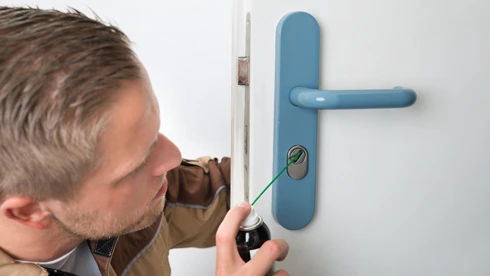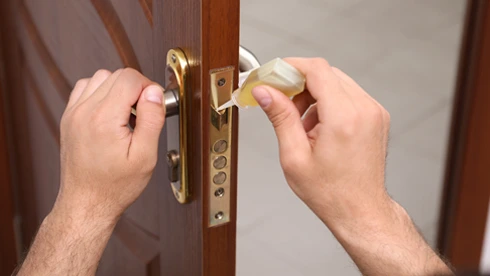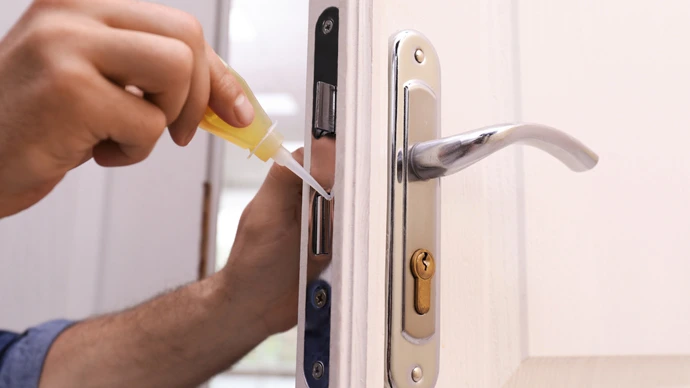You’re in a hurry to get out of the house, but your door lock is being uncooperative. It may be too hard to turn, or the latch may just keep sticking. One of the most common causes of door lock malfunctions is a lack of lubrication.
Before you start tugging on the doorknob or banging on the door in disappointment, try a little lubrication. This will help keep your locks working properly and prevent them from becoming sticky over time.
But do you know how to lubricate a door lock and how to do it properly? If not, we have the solutions for you!
Throughout this article, we will provide some steps on how to do it properly, so you can ensure that your door key locks are well-lubricated and working smoothly. Let’s get started!
Here are Steps on How to Lubricate a Door Lock

When your door lock starts to feel stiff or difficult to turn, it’s time for some lubrication. Follow these simple steps to get the job done:
Step 01: Assembly All You Needs
First, gather the following items:
- Lubricant (WD-40, silicone spray, graphite powder, etc.)
- Spray Straw
- Cotton swabs
- Paper towels
You can also gather some additional tools if needed, such as a screwdriver, a plier, or a wrench for more stubborn locks.
Step 02: Check and Clean the Lock
Before you start spraying any substance in the keyhole and latch, it’s important to check the lock and see if there is any debris or dirt that needs to be removed. Use a Q-tip or a cotton swab to clean out the door lock mechanism and remove any built-up grime.
Also, you can use your vacuum cleaner to suck up any debris or dirt that may be around the latch and keyhole. If the lock is really dirty, you can also use a damp cloth to wipe it down. This will help avoid any unwanted messes.
The keyhole may need to be cleaned with a stronger solvent, such as acetone or alcohol if the keyhole is really dirty. Be careful not to get any of these solutions on the door or the surrounding area, as they can be damaging.
Step 03: Apply Lubricant in Door lock and Keyway

Once the lock is clean, it’s time to apply lubricate door locks and keyway. There are many different types of lubricants that you can use, but WD-40 is a common and effective choice.
Spray a small amount of liquid directly into the keyhole and door latch. Then, use a cotton swab to spread the lube around the inside of the lock. Be sure to apply it evenly and make sure that you get into all the nooks and crannies.
Step 04: Wipe Away Excess Lubricant
After you’ve applied the lubricant, it’s important to wipe away any excess. Use a paper towel or a cloth to clean up any messes. This will help avoid any damage to the lock’s keyhole and latch or the surrounding area.
You can also use a vacuum cleaner to remove any excess liquid around the keyhole and latch. But be careful not to suck up the fluid and deposit it into the vacuum cleaner motor. Another option is to blow the fluid away with a leaf blower.
Step 05: Use a Key to Test the Lock
Now, try inserting your key into the lock and see if it turns smoothly. If it does, you’re done! But if it doesn’t, then you might need to use more fluid.
If the key is still difficult to turn, you can try using a screwdriver, pliers, or wrench to apply more pressure while you’re turning the key. Then, close the door and give it a good tug to make sure it’s locked properly.
Step 06: Repeat as Needed
If the lock still doesn’t seem to be working properly after servicing it, you may need to repeat the process. You can also try using a different type of lube if the first one doesn’t seem to be working.
Just be sure to clean the lock before applying any new lubricant, so that the new product can work its best.
Regularly taking care of your locks will help keep them working smoothly and prevent them from becoming stuck over time. If you follow these simple steps, you can easily take care of this task yourself!
Additional Factors During Lubricate Door Locks

Door key locks are one of those items in life that you don’t think about until they stop working. And by then, it’s often too late. So, it’s important to be proactive and lubricate your locks on a regular basis. There are a few other factors to keep in mind when servicing your outdoor locks:
Use the Right Type of Lubricant
Different types of locks require different types of liquid. So, be sure to use the right type of lubrication for your specific lock. Due to its versatility, WD-40 is a good choice for most locks.
Avoid Using Too Much Lubricant
It’s important not to use too much lubricant, as this can actually cause more damage than good. Excess fluid can seep into the locking mechanism and make it difficult to open the door. It can also attract dirt and debris, which can create more problems down the road.
Be Patient and Take Your Time
Lubricating a lock can be a bit of a tedious task. So, take your time and be patient. If you rush through it, you might not do a good job, and the lock may not work properly.
By following these simple steps, you can easily take care of this task yourself! And, by maintaining your door hinges, and door locks regularly, you can help prevent them from becoming stuck or damaged.
How to Deep Clean a Door Lock?

If you want to deeply clean a lock, you need to disassemble it from the door. The following steps will show you how to do this:
Step 01: Remove the Lock from the Door
Use a screwdriver or pliers to remove the two screws that hold the lock in place. Be careful not to damage the screws or the surrounding area.
Step 02: Disassemble the Lock
Once the screws are removed, you can take the lock picking apart. This will give you access to all the parts of the lock that need to be cleaned.
Step 03: Clean the Parts with WD-40
Spray WD-40 dry lube on a paper towel and use it to clean all the parts of the lock. Be sure to get into all the nooks and crannies. Once the parts are clean, use a paper towel or a cloth to wipe away any excess WD-40 penetrating fluid.
Step 04: Apply Graphite Lubricant
Once the parts are clean, apply a small amount of graphite powder or dry lubricant to the keyhole and all moving parts. Powdered graphite is a good choice, as it won’t attract dirt and debris as liquid lubricants can.
Step 05: Use Extra Products
You can also use grease lube, pencil lead, key oil, or a silicone spray to lubricate the lock, and you can collect them from hardware stores. However, be careful not to use too much, as this can cause more damage than good.
Step 06: Reassemble the Lock
Once the fluid is applied, put the lock back together and reattach the lock cylinder to the door. Be sure to screw it in securely, so it doesn’t come loose.
If you follow these simple steps, you can easily deep clean your lock! This will help keep it functioning properly your car door lock also and prevent it from becoming stuck or damaged.
Frequently Asked Questions
There are a few questions that are commonly asked about the lubrication of door locks:
1. Can You Use Vaseline to Lubricate a Lock?
While Vaseline can be used to lubricate some locks into key begins, it is not recommended. It is a thick, sticky lock substance that can attract dust and debris. This can create more problems for the lock in the long run.
2. How Often Should You are Lubricating Door Lock?
It is recommended to lubricate the lock and hinge on a regular basis, but the frequency will depend on the type of lock and how often it is used. Generally, lubrication every 6 to 12 months is a good rule of thumb.
3. How Can I Tell if My Door Lock Needs Lubricating?
If the lock is difficult to open, or if it makes a grinding noise when you try to turn it, it may need lubrication. You can also check the keyhole for signs of rust or corrosion. If you see any of these signs, it’s time to lubricate the lock.
4. What Kind of Lubricant Should I Use?
There are many types of lubricants available, such as WD-40, graphite powder, silicone spray, grease lube, key oil, etc. However, not all of these products are suitable for every type of lock. Be sure to read the instructions carefully and use the appropriate fluid.
Conclusion
Lubricating a door lock is a simple task that can help keep it functioning properly. By following the above discussion in this article, you can easily take care of this task yourself. And, by lubricating your door locks regularly, you can help prevent them from becoming stuck or damaged.
We hope now you know how to lubricate a door lock. In the comment section below, feel free to ask any questions you may have. And, if you found this article helpful, please share it with your friends and family.
Related Posts:
- as
